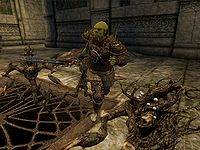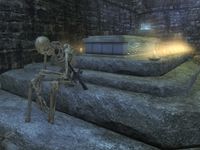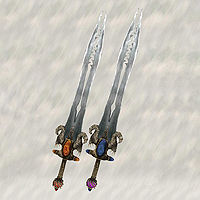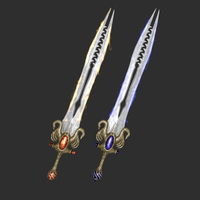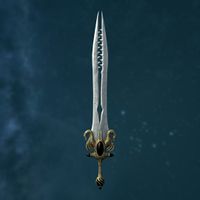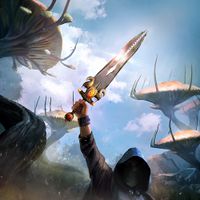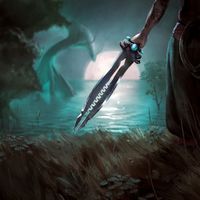Lore:Dawnfang and Duskfang
| Dawnfang and Duskfang | |||
|---|---|---|---|
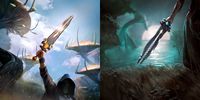 Dawnfang and Duskfang
Dawnfang and Duskfang |
|||
| Culture | Tsaesci | ||
| Appears in | Shivering Isles, Skyrim(CC) | ||
Dawnfang and Duskfang, and their superior variants, Dawnfang Superior and Duskfang Superior, are four forms taken by an evidently sentient Tsaesci "blood drinker" longsword.[1] Dawnfang and Duskfang's serpent-like appearance and transformation capabilities are reminiscent to traits that the Tsaesci are rumored to have.[UOL 1] The sword has a sinister purpose: corrupting its wielder, as well as forcing a dependency on them.[2] It also craves the lifeforce and magicka of the victims it slays.[3]
Dawnfang and Duskfang's design is intricate in all its forms, an example being its crossguard and pommel that are adorned with elegant jewels, placed as if to seduce a person into wielding it. More fitting of its nature is its pronged blade that resembles the gaping maw of a beast, and the golden snakeskin pattern that envelops the areas around its crossguard, handle, and pommel. The forms' physical similarities diverge from there thanks to the sword's transformative capabilities. At dawn, the sword becomes Dawnfang, whose jewels become infused with orange flames and burns to those that it strikes. At dusk, the sword becomes Duskfang, and its jewels become infused with blue cold flames, but the pommel's jewel may differ from the rest as its flames can be in either a blue or purple color. Nonetheless, the form freezes those it strikes.[4][5]
The sword's superior forms are achieved by "feeding" the sword after every transformation. It informs its wielder through a mental connection how many lives it must claim before it is satisfied.[1] If twelve enemies are killed with the sword over the twelve-hour period, the next transformation will result in the Superior variant. Dawnfang Superior is engulfed in orange flames around its blade and absorbs the health from those that it strikes, while Duskfang Superior is engulfed in cold flames around its blade and drains enemies of their magicka reserves.[4][6] The sword instantly repairs itself and recharges its enchantments when it transforms. When the sword is not wielded, its jewels turns into a black void-like color, as if inactive and resting.[5]
History[edit]
Third Era[edit]
The sword was originally forged in Akavir by the Tsaesci. It somehow made its way to Tamriel, where it ended up inside a metal box in the depths of the undead-infested Ayleid ruins of Trumbe, in the rugged highlands of the Gold Coast. In 3E 431, the box was looted from the ruins by a small band of adventurers. The sword was then claimed by the Orc warrior Grommok gro-Barak, who is responsible for giving the artifact its various names. Grommok quickly discovered the sword's unusual enchantments, and reported hearing a voice in his head counting each kill he made with the sword.[1]
Following the sword's discovery, the adventurers departed to explore the area around Niben Bay. Around two years later in 3E 433, Sheogorath opened a portal to the Shivering Isles in the center of the bay in search of a mortal champion. The Hero of Kvatch entered the realm, earning citizenship by killing the Gatekeeper of the Fringe. Without the Gatekeeper guarding the Gates of Madness, the Isles were left open to sane mortals. It was at this time that the group of adventurers entered the realm. At the command of Sheogorath, the facility of Xedilian was restored to working order, and began to magically attract "unwanted visitors". Grommok's group were the first to fall victim to the restored facility, and all three members were either killed or driven mad by the various traps within. The Hero of Kvatch, who oversaw the entire procedure, was then given the artifact after it was taken from Grommok.[7]
Fourth Era[edit]
The sword was at one point acquired by Lorant Bouchard, an infamous Blades captain who was rumored to be part serpent. The death of his wife Emma,[3] and the sword's influence combined to weigh down on him,[2] causing him to fall further into madness. He begin taking out his suffering on others, and he even began to dabble in necromancy. In 4E 130, the necromancer Sychelle Gatharian hired a group of mages under the guise that they were to capture Lorant for his treachery. Their initial encounter with Lorant failed miserably and they were forced to retreat.[3] They found his experience as a swordsman in combination with his sword, and his ability to resurrect those he killed overwhelming.[8] The mages realized that to defeat him, the best course of action was to somehow separate him from his sword.[3] Sychelle made preparations to fund a second attempt to capture Lorant. She hired a group of smugglers to aid the mages in fulfilling their contract,[9] and revealed her hidden motive to their boss, Verrick Tilwald. She had in her possession a similar blade known as Bloodthirst, and revealed that the capture mission was a front to obtain Dawnfang and Duskfang so that it may be swapped with Bloodthirst. She insisted that he keep the plan secret from the mages, and the deal was sealed with the exchange of a coin. Verrick had other plans however, and plotted to betray his mage allies and employer if they were successful with retrieving Dawnfang and Duskfang. Unfortunately, before he and his associates made the journey to fight Lorant, he lost Bloodthirst within Faldar's Tooth in the Rift.[8]
With their plan finalized, the mages made their move and located Emma's remains. They relocated it to a vault in Riften's Ratway and intended to use it as a lure.[10] Lorant tracked them down and intended to slaughter them for their audacity to disturb his wife, and upon his arrival the mages and smugglers sprung their trap. The mages were successful in separating him from his sword, sealing it behind an impenetrable barrier in the vault's central chamber. Unfortunately, something interfered with the separation spell, and its unintended effect divided Lorant into three different hostile spirits. Several theories of what lead to this unfortunate event emerged. One mage concluded that the spell failed because magic is inheritably unpredictable, [11] while another theorized that the sword may have an ability to interfere with magic.[12] Verrick was the one most to blame. He noted that his incompetence led to Bloodthirst being lost, causing a significant divergence from the plans Sychelle laid out for him.[8] Sensing their imminent demise, the mages worked to binding Lorant into three different areas of the vault, and summoned Emma's spirit in hopes of using her to convince her husband to calm down.[13] The little time they had left allowed them to successfully complete the binding ritual, but at the cost of all but one of them being sealed inside with the vengeful Lorant.[14] As Verrick waited for his demise, he realized that the coin Sychelle had given him had been cursed, perhaps indicating how his greed led to his downfall.[8] Lorant remained within the tomb as its prisoner, and as the guardian for the sword and his wife's remains; all who entered the tomb were killed by him.[2][6]
In 4E 201, the Last Dragonborn investigated Riften's Ratway after hearing rumors of disappearances and ghost sightings. Within the Ratway, the spirit of Lorant's long-departed wife, Emma, manifested and guided the Dragonborn through Lorant's chambers. The Dragonborn defeated Lorant's fragments and made him whole, finally freeing him and allowing him to reunite and rest with his wife in the afterlife. With Lorant free, the barrier surrounding Dawnfang and Duskfang was removed, allowing the sword to be retrieved.[6]
Previous Owners[edit]
Gallery[edit]
Notes[edit]
- A similar sword known as Bloodthirst was seen circa 4E 180 and 4E 201. It was visually identical to Dawnfang, but instead has red jewels that swirls with blood. It earns its name due to its unquenchable appetite for blood. Similarly to Dawnfang and Duskfang, it can absorb the health of those it cuts and can self-repair. However, Bloodthirst does not transform at night.[15]
- A similar sword known as Rimelink was seen circa 4E 180. It was visually identical to Duskfang, but has a shade of cyan instead of a dark blue. Its attacks are cold based.[16]
- The Talisman of Abetment is an amulet crafted in a similar style to Dawnfang. It was similarly taken from the adventurers after their doom in Xedilian, but nothing else is known of it.[7]
See Also[edit]
- For game-specific information, see the Shivering Isles and SkyrimCC articles. Legends has separate card articles for Dawnfang and Duskfang.
References[edit]
- ^ a b c Grommok's Journal — Grommok gro-Barak
- ^ a b c Sellonus's Confession — Sellonus
- ^ a b c d Sellonus's Journal Vol. 1 — Sellonus
- ^ a b Dawnfang and Duskfang items in Oblivion: Shivering Isles
- ^ a b Dawnfang/Duskfang items in Dawnfang and Duskfang Creation Club
- ^ a b c A Soul Divided quest in Skyrim
- ^ a b Events of Oblivion: Shivering Isles
- ^ a b c d Verrick's Note — Verrick Tildwald
- ^ Old Smuggler's Note
- ^ Sellonus's Journal Vol. 2 — Sellonus
- ^ Guild Mage's Warning
- ^ Guild Mage's Note
- ^ Guild Mage's Missive
- ^ Sellonus's Journal Vol. 3 — Sellonus
- ^ Bloodthirst item in Blades
- ^ Rimelink item in Blades
Note: The following references are considered to be unofficial sources. They are included to round off this article and may not be authoritative or conclusive.
